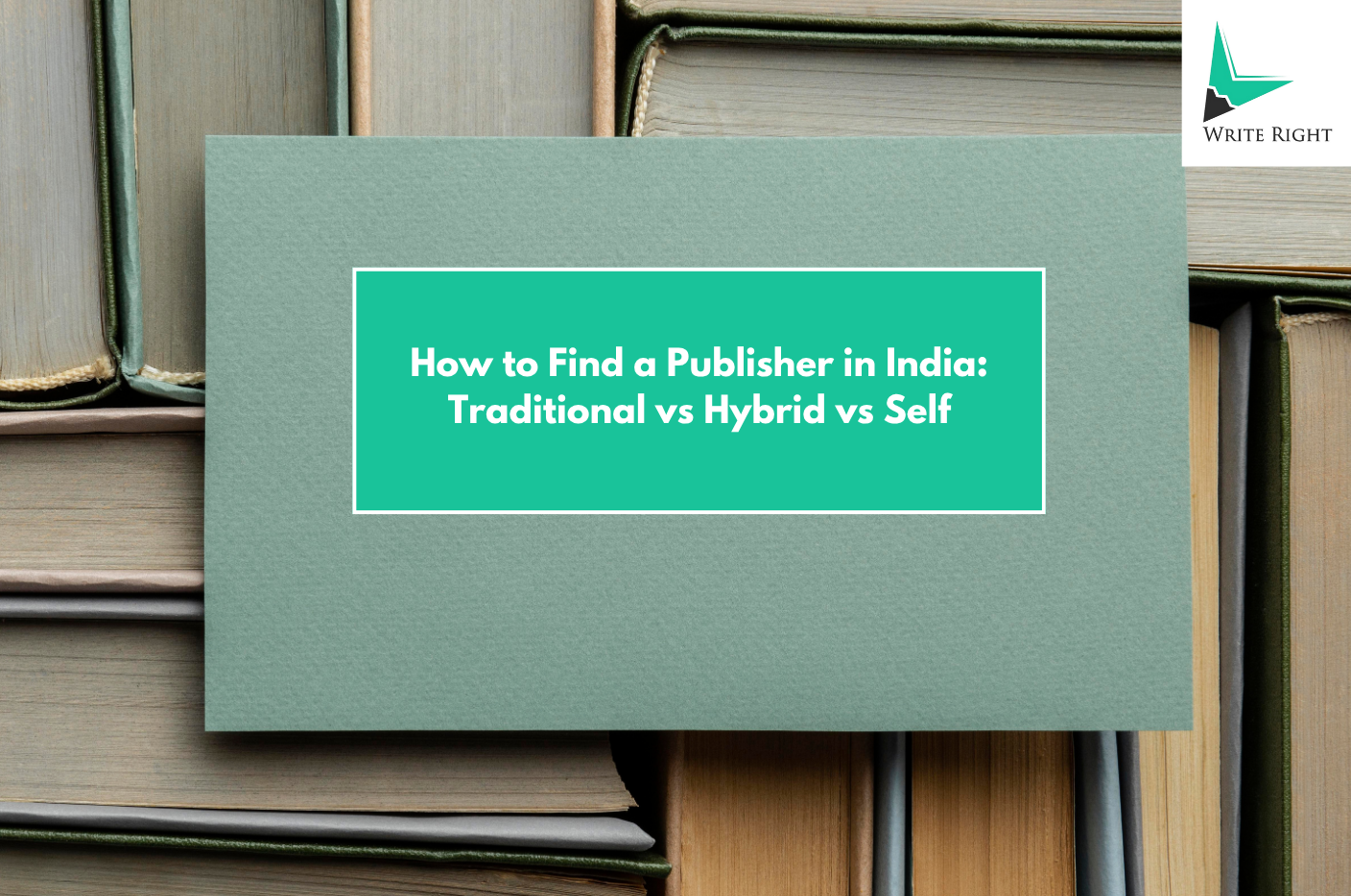Finding a credible publisher in India in 2025 can feel like a task. With traditional, hybrid, and self-publishing options, authors often wonder how to get their book published without falling into scams or wasting time. Many writers struggle with knowing where to send a manuscript, which publishers are legitimate, and how to make their submission stand out.
To find a reputable publisher in India, first choose the right path, build credibility signals with a polished manuscript and platform, and submit only to vetted houses while avoiding vanity press red flags.
At Write Right, we help authors navigate this process confidently. By clarifying the publishing path, building credibility signals, and providing safe submission strategies, we’ve guided over 500 Indian authors to land legitimate deals. This guide answers the key question: how to find a publisher to publish your book in India while avoiding pitfalls, understanding traditional vs hybrid vs self-publishing, and ensuring your manuscript reaches the right hands.
Step 1: Decide Your Path: Traditional vs Hybrid vs Self
Choosing the right path sets the foundation for your publishing journey. It influences timelines, costs, control, and the kind of audience your book reaches.
Traditional Publishing
Traditional publishing in India requires no upfront payment from the author. Publishers manage editing, design, and distribution, and may offer an advance and royalties. Selection is highly competitive. Success depends on market fit, genre demand, and a polished submission.
At Write Right, we help authors refine their manuscripts and proposals so they are submission-ready, increasing the chances that acquisitions editors will take notice. Our team also guides authors on market positioning and genre alignment to strengthen publisher appeal.
Expert Insight: An ex-acquisitions editor at Write Right notes, “Editorial fit plus proof of market potential consistently outweighs author fame when publishers decide on acquisitions.”
Hybrid Publishing
Hybrid publishing involves shared investment between the author and publisher. Contracts vary, and the quality of distribution and editorial support is crucial. Write Right assists authors in evaluating hybrid publishers, comparing terms, and ensuring they are choosing a reputable partner.
Authors often choose hybrid for faster timelines, especially if they have seasonal or academic targets, as Write Right has seen with debut authors releasing school-focused books.
Self-Publishing
Self-publishing gives you full control. Authors invest in production and marketing. Without professional guidance, the process can be overwhelming. Write Right provides end-to-end support for self-publishing: editing, formatting, ISBN registration, and distribution on platforms like Amazon, KDP, and Google Books.
Read This Guide Before Choosing: Self-Publishing Vs Traditional? Pros, Cons, and What Makes More Money
Quick Chooser Grid
| Goal | Genre | Budget | Timeline | Suggested Path |
| Mass-market fiction | General fiction | Low | 12–18 months | Traditional |
| Educational or seasonal nonfiction | Schools/Institutes | Medium | 6–9 months | Hybrid |
| Niche | Any | Flexible | Fast | Self-publishing |
Case Study: An author compared traditional, hybrid, and self-publishing with Write Right guidance and chose hybrid to hit the school season launch, balancing speed with professional credibility.
Your Book, Professionally Published
Write Right transforms your manuscript into a polished book ready for readers, with expert formatting, editing, and publishing support.
Step 2: How Traditional Publishing Works in India (at a Glance)
Understanding how book publishing works in India, especially the traditional route, helps you approach publishers strategically. Knowing what publishers expect and how they evaluate submissions can prevent wasted time and frustration.
Gatekeepers: Agents and Acquisitions Editors
Most traditional Indian publishers rely on agents or acquisitions editors to filter manuscripts. Editors may review unsolicited submissions (slush pile), but referrals or polished submissions have higher chances. At Write Right, we guide authors on how to present their manuscripts to appeal to these gatekeepers, increasing the likelihood of consideration.
Key Insight: Acquisitions editors focus on editorial fit, market potential, and professionalism. Manuscripts that meet these criteria get moved from “maybe” to “meeting” fast.
Materials: What You Need to Submit
- Fiction: Full manuscript. Publishers expect a completed story with clean formatting, strong narrative, and consistent pacing.
- Nonfiction: A proposal with 2 to 3 sample chapters. This demonstrates authority, concept clarity, and your ability to deliver actionable content.
Write Right helps authors craft these materials to align with industry expectations. Our team reviews proposals, sample chapters, and manuscript formatting so submissions reflect credibility and professionalism.
Internal Path: From Submission to Offer
Once your manuscript or proposal reaches the publisher:
- Editorial Read: An editor reviews for content quality, market fit, and originality.
- Acquisitions Meeting: Editors and managers discuss whether to move forward.
- Contract Offer: If approved, terms, including advance, royalties, and rights are negotiated.
Expert Insight: A former acquisitions editor at Write Right explains, “Submissions that show clear market rationale and a strong reader promise consistently reach the acquisition meeting faster.”
Simple Flowchart
Author → Agent/Editor → Acquisitions → Offer
This visual shows the high-level traditional publishing process in India. At Write Right, we provide detailed templates and checklists to ensure every step from manuscript polish to submission is covered.
Mini Tip: Understanding this process prevents authors from submitting blindly. Knowing how book publishing works ensures you target the right publisher and submit materials in a way that editors respect.
From Idea to Bestseller
We guide authors through every publishing step from concept, editing, and design to online and print distribution.
Step 3: Build Your Credibility Signal Stack
Building credibility is critical if you want Indian publishers to take your submission seriously. Editors and acquisitions teams look for signals that you can reach readers, deliver on your book promise, and maintain professional standards.
Market Rationale: Positioning and Comps
Start by explaining your book’s market rationale in a sharp paragraph. Answer why your book matters and which gap it fills in the market. Include 3 to 5 comparable titles (comps) and show how your book is unique.
At Write Right, we help authors create this “comps stack” so editors immediately understand market fit. A strong rationale answers the question: “Where can I get my book published that will actually value this content?”
Pro Tip: Focus on measurable gaps in existing books rather than generic comparisons.
Proof of Audience: Demonstrate Demand
Publishers want authors who can reach readers. Signals include:
- Relevant credentials or domain expertise
- Teaching, speaking, or workshops
- A small but engaged email list
- Early endorsements or testimonials
Write Right works with authors to gather these proof points, even for first-time writers, making submissions appear stronger and credible.
Case Study: An author updated her bio and included three high-value comps through Write Right’s guidance. She received requests for partial reads from two top Indian imprints within six weeks.
Professionalism Signals: Manuscript and Proposal Quality
Your manuscript or proposal should be polished, well-formatted, and free of errors. Consistency in the author bio, synopsis, and query tone adds professionalism.
Write Right provides manuscript reviews, proposal templates, and author bio frameworks that align with industry expectations. This ensures your submission communicates competence and reliability.
Endorsement Frame
Request short pre-publication blurbs from domain experts. Even one sentence from a recognized figure increases credibility. Write Right provides templates to make these requests professional and persuasive.
Expert Insight: A senior acquisitions editor notes, “Credibility stacks matter more than social media metrics alone. A clean, well-positioned proposal tells me this author can deliver and connect with readers.”
Credibility Signal Table
| Signal Type | Example | How Write Right Helps |
| Market Rationale | 3–5 comps + unique gap | Guides identification & presentation |
| Proof of Audience | Email list, workshops, endorsements | Builds an early author platform |
| Professionalism Signals | Manuscript/proposal formatting, bio, synopsis | Editing & template support |
| Endorsements | Expert pre-publication blurbs | Provides outreach templates |
A strong credibility stack answers the publisher’s unspoken question: “Is this author serious, prepared, and market-aware?” With Write Right’s guidance, you can submit confidently to top Indian imprints like Penguin, HarperCollins, or Rupa.
Get Your Book in Readers’ Hands
Write Right handles print and digital publishing so your book reaches Amazon, Google Books, Apple Books, and more.
Step 4: Safe Publisher Discovery: Where to Send Your Book
Finding legitimate publishers in India can be confusing. Knowing where to publish your book and avoiding vanity or predatory presses is essential for first-time authors. The right targets save time, improve acceptance odds, and protect your rights.
Start Lists: Reputable Imprints and Agents
Begin with reputable Indian imprints by genre. Check award shortlists, bestseller lists, and catalogs to reverse-map houses that align with your book. Agents can help, especially for larger or traditional houses.
Write Right maintains a curated shortlist of credible Indian imprints across genres. We guide authors on matching their manuscript to the right editorial team, ensuring submissions land where they have a real chance of success.
Pro Tip: Avoid publishers who do not show recent debuts or lack proper distribution. Past success of similar titles is a stronger signal than brand recognition alone.
Submission Rules: How to Approach
Check the publisher’s submission guidelines. Important points include:
- Open submission windows or agented-only policy
- Preferred format (email, portal, or hard copy)
- Simultaneous submission rules
- Expected response times and etiquette
Write Right trains authors on professional submission behavior, from email formatting to follow-up timing, making first impressions count.
Case Study: A nonfiction author targeted 12 credible imprints. Three requested partial reads, and one extended an offer within nine weeks. Proper adherence to submission protocols was key.
Research Checklist: Vetting Publishers
Before sending your manuscript or proposal, check:
- Genre catalog match
- Recent debut titles and their sales
- Print + digital distribution capabilities
- Bookstore visibility and returns policy for trade houses
Write Right provides a comprehensive research framework for each target publisher. This ensures authors answer the critical question: “Where can I get my book published safely and effectively?”
Insight
An operations manager at a top Indian publishing house notes, “Backlist health and recent debut successes are more reliable than brand hype when considering new submissions.”
Publisher Research Tracker
| Publisher/Imprint | Genre Fit | Submission Type | Recent Debuts | Distribution | Notes/Follow-Up |
| Penguin Random House | Fiction | Agent Required | 3 | Print+Digital | Follow-up in 6 weeks |
| HarperCollins India | Nonfiction | Open Email | 2 | Print+Digital | Track response time |
| Rupa Publications | Children | Portal Only | 1 | Verify returns policy |
Safe publisher discovery reduces risk, increases acceptance probability, and ensures your manuscript is seen by the right editorial decision-makers. With Write Right’s guidance, Indian authors can confidently navigate this landscape.
Affordable & Hassle-Free Publishing
From self-publishing to premium packages, Write Right ensures quality publishing without hidden costs or delays.
Step 5: Spot & Avoid Vanity/Predatory Offers
Not all publishing offers in India are legitimate. Learning where to send a book for publishing safely means recognizing red flags and avoiding costly mistakes. Predatory or vanity presses can waste money, grab rights, and stall your career.
Red Flags to Watch
Key warning signs include:
- Mandatory purchases of books, marketing, or packages
- Pay-to-win awards or “guaranteed bestseller” claims
- Reading or submission fees
- Pressure tactics or strict, unreasonable deadlines
Write Right educates authors on spotting these traps before submitting, ensuring you focus on legitimate publishers that value your work.
Contract Traps
Even if the publisher seems credible, contracts can hide problems:
- Perpetual rights grabs beyond your book
- Non-itemized marketing fees
- Missing audit or royalty clauses
- Ambiguous payment timelines
Authors working with Write Right learn how to read contracts critically and negotiate terms that protect their rights and revenue.
Verification Moves
Before signing, verify:
- Distributor or retailer IDs
- Sample royalty statements from other authors
- At least two references from recent authors
These steps confirm the publisher operates ethically and pays accurately.
Case Study
An author nearly signed with a vanity press promising a “best-seller package.” Using Write Right’s 10-point red-flag checklist, they recognized upfront costs, vague marketing claims, and perpetual rights clauses. They avoided a ₹70,000 loss and redirected their manuscript to three vetted traditional houses, receiving a contract from a credible hybrid publisher within eight weeks.
Insight
A publishing lawyer specializing in Indian contracts advises, “Audit rights and clear royalty terms are non-negotiable. Any publisher unwilling to provide transparency is a risk.”
10-Point Red Flag Checklist
| Red Flag | What to Check | Action |
| Mandatory purchases | Are you required to buy books/packages? | Avoid submission |
| Pay-to-win claims | Promises of a bestseller without merit | Investigate credibility |
| Reading/submission fees | Are fees charged for consideration? | Decline |
| Pressure deadlines | Unrealistic time pressure | Reassess |
| Perpetual rights grabs | Ownership terms unclear | Consult a lawyer/agent |
| Non-itemized marketing | Costs not broken down | Request an itemized list |
| Missing audit rights | Can you review sales reports? | Insist on an audit clause |
| Unverified distributor | No retailer/distributor ID | Verify via independent sources |
| Author references missing | Cannot contact recent authors | Reach out to known contacts |
| Vague revenue timelines | No payment schedule | Require clear terms |
Avoiding vanity and predatory publishers protects your investment, intellectual property, and future career. With Write Right, Indian authors gain expert guidance on evaluating offers, spotting red flags, and submitting safely.
Expert Publishing, Maximum Impact
Write Right ensures your book looks professional, sells well, and reaches your target readers with the right strategy.
Step 7: How to Get Published by Penguin? The Realistic Route
Many authors wonder how to get their book published by Penguin or other marquee Indian publishers. While the brand is attractive, the path requires realistic planning, persistence, and proper alignment.
Fit First: Imprint-Genre Alignment
Top houses like Penguin are selective. The first rule is to target the right imprint for your genre and market:
- Match your book’s theme, style, and audience with the imprint’s catalog
- Avoid chasing a brand just because of its prestige
- Focus on whether your work fills a gap in the publisher’s list
Write Right guides authors in mapping their manuscripts to suitable imprints, ensuring a higher chance of acceptance.
Gateways: How to Reach Them
There are a few practical ways to approach Penguin or similar publishers:
- Agented Submissions: Most big imprints prefer submissions through literary agents. Finding an agent increases credibility and reduces the chance of automatic rejection.
- Open Calls: Occasionally, Penguin opens submission windows for specific categories or competitions. Authors should track these windows closely.
- Anthology/Contest Pathways: Contributing to a reputable anthology or contest can create a proven track record, making your full-length submission stronger.
Prepare for Persistence
Getting accepted by a marquee publisher often takes multiple rounds:
- Strengthen your comps section and update your author credentials between cycles
- Revise your proposal or manuscript based on prior feedback
- Consider publishing your first book with a credible mid-list imprint before moving to a marquee house
Write Right helps authors refine submissions and credibility signals, making follow-up cycles more effective.
Case Study
A debut fiction author approached a mid-list Penguin imprint after consulting Write Right. Their first book was accepted for a mid-list launch. Six months later, after sales proved demand and the author improved their positioning and comps, the second manuscript moved to a marquee line within Penguin, gaining higher visibility and marketing support.
Insight
An experienced literary agent notes, “Persistence combined with the right alignment, credibility signals, and strategic sequencing often beats immediate brand chasing.”
Conclusion
Finding a publisher in India in 2025 requires clarity, strategy, and careful vetting. To confidently answer the question, Where can I get my book published or How to get your book published, start by choosing the right path: traditional, hybrid, or self-publishing. Build credibility with a strong proposal, manuscript, comps, and professional author signals. Research imprints carefully, avoid vanity or predatory offers, and submit strategically using a shortlist and batch approach.
Using structured guidance, like Write Right’s author support, helps reduce risk, improve submission quality, and increase chances of landing a legitimate publishing deal. Remember, the goal is alignment and persistence, not chasing prestige alone.
Frequently Asked Questions
Should I pursue traditional, hybrid, or self-publishing for my book?
The choice depends on your goals, timeline, budget, and control preference. Traditional publishing offers credibility and no upfront cost, but longer timelines. Hybrid publishing requires partial investment but a faster launch. Self-publishing gives complete contro,l but you handle production and marketing. Write Right helps authors evaluate which path fits their genre, audience, and career goals.
What materials do Indian publishers usually want in a submission?
For fiction, most houses request a full manuscript. Nonfiction requires a proposal with 2–3 sample chapters. Include a clean, polished manuscript, synopsis, and author bio. Write Right provides templates and review guidance to make your submission professional and credible.
How can I make my submission more credible to top Indian imprints?
Credibility comes from a strong reader promise, clear comps, proof of audience (social following, email list, or endorsements), and polished presentation. Highlight any teaching, speaking, or awards. Using Write Right’s credibility checklist ensures your proposal signals professionalism and market fit.
How do I find legitimate publishers and avoid vanity presses?
Start with reputable imprints by genre, agent shortlists, award catalogs, and bookstore distribution presence. Avoid publishers asking for mandatory fees, guaranteed bestseller claims, or unclear marketing packages. Write Right provides a red-flag checklist to protect authors from scams.
Are reading fees normal in India?
No, legitimate publishers do not charge reading fees. Any request for upfront payments for consideration is a red flag. Use Write Right’s safe submission guidance to verify publishers before sending your manuscript.
How many publishers should I pitch at once, and can I submit simultaneously?
Pitch in batches of 6–8, adjusting based on responses. Simultaneous submissions are acceptable if publishers’ policies allow. Track dates, responses, and follow-ups with Write Right’s Submission Tracker to stay organized and efficient.





